-
 Bitcoin
Bitcoin $105,953.9980
3.06% -
 Ethereum
Ethereum $2,445.3292
6.68% -
 Tether USDt
Tether USDt $1.0006
-0.03% -
 XRP
XRP $2.1968
7.03% -
 BNB
BNB $643.2903
2.13% -
 Solana
Solana $144.2799
3.82% -
 USDC
USDC $1.0000
-0.03% -
 TRON
TRON $0.2739
0.49% -
 Dogecoin
Dogecoin $0.1642
4.47% -
 Cardano
Cardano $0.5834
5.49% -
 Hyperliquid
Hyperliquid $38.0741
2.80% -
 Sui
Sui $2.7741
7.56% -
 Chainlink
Chainlink $13.4107
11.26% -
 Bitcoin Cash
Bitcoin Cash $450.4828
-0.61% -
 UNUS SED LEO
UNUS SED LEO $9.1301
0.64% -
 Stellar
Stellar $0.2476
5.49% -
 Avalanche
Avalanche $18.0637
5.09% -
 Toncoin
Toncoin $2.9066
2.43% -
 Shiba Inu
Shiba Inu $0.0...01160
4.01% -
 Hedera
Hedera $0.1527
8.00% -
 Litecoin
Litecoin $84.6122
2.37% -
 Monero
Monero $317.6076
5.76% -
 Ethena USDe
Ethena USDe $1.0008
0.02% -
 Polkadot
Polkadot $3.4519
5.27% -
 Dai
Dai $1.0000
-0.03% -
 Bitget Token
Bitget Token $4.2835
5.62% -
 Uniswap
Uniswap $7.0443
9.78% -
 Pepe
Pepe $0.0...09964
7.41% -
 Pi
Pi $0.5391
4.64% -
 Aave
Aave $264.1743
11.26%
How to judge the appearance of a small positive line with a pile of volume in the bottom area?
A small positive line with high volume in the bottom area may signal early accumulation and a potential bullish reversal in crypto markets.
Jun 24, 2025 at 11:00 pm
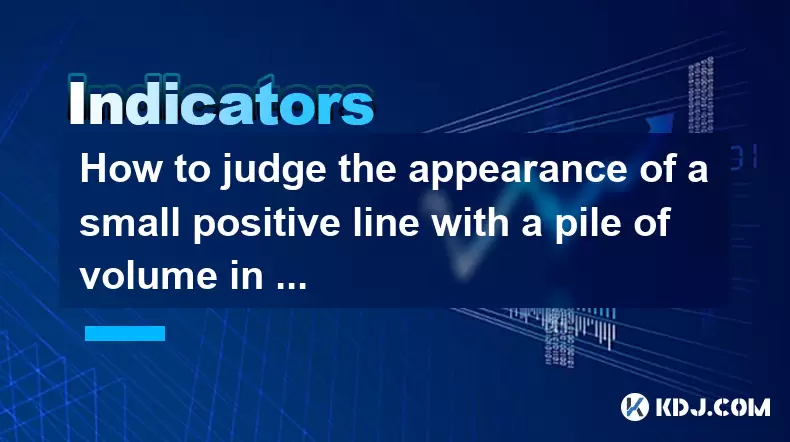
What Is a Small Positive Line with High Volume in the Bottom Area?
A small positive line refers to a candlestick pattern where the price opens and closes within a narrow range, but the closing price is slightly higher than the opening price. This candlestick typically has short upper and lower shadows. When this type of candle appears along with a pile of volume, meaning trading volume is significantly higher compared to previous sessions, it can signal potential market behavior shifts.
In the context of technical analysis, especially within cryptocurrency markets, such patterns often appear after prolonged downtrends. When they occur in what's known as the bottom area—a region where prices have fallen significantly and are approaching historical or support levels—it may indicate early accumulation by institutional buyers or whales.
How to Identify the Bottom Area in Cryptocurrency Charts
Identifying the bottom area involves analyzing historical price action and key support zones. In crypto charts, these areas often correspond to prior lows, Fibonacci retracement levels, or long-term moving averages like the 200-day EMA.
To locate the bottom area:
- Look for zones where price has previously reversed from.
- Check for confluence between multiple indicators (e.g., RSI reaching oversold territory and price touching a trendline).
- Observe if the volume profile shows increased activity near certain price levels.
These zones are crucial because they often serve as psychological barriers. When a small positive line forms here with high volume, it suggests that buyers are stepping in despite ongoing bearish sentiment.
Understanding the Significance of High Volume in This Context
Volume is a critical component when interpreting candlestick patterns. A spike in volume during a small positive line formation at the bottom area could mean several things:
- It may reflect accumulation by large players, who begin buying while retail traders are still selling off their positions.
- The increase in volume might indicate market interest returning, even though the price hasn't moved much.
- It could also suggest that sellers are exhausted, as evidenced by the inability to push the price lower despite heavy trading.
Traders should compare this volume to the average volume over the past 20–30 candles. If it’s substantially higher, it reinforces the likelihood of a meaningful reversal or consolidation phase beginning.
How to Distinguish Between a Genuine Signal and a False One
Not every small positive line with high volume in the bottom area leads to a strong reversal. To avoid false signals:
- Wait for confirmation in the following candles. A bullish engulfing pattern or a close above a recent resistance level can validate the initial signal.
- Use oscillators like MACD or RSI to confirm momentum shifts. For instance, an RSI crossing above 50 after being below 30 can add credibility.
- Examine the broader market context. If Bitcoin or Ethereum is showing strength, altcoins forming similar patterns are more likely to follow suit.
False positives often occur during "dead cat bounces," where brief rallies happen amid strong downtrends. These usually lack sustained volume and fail to break key resistance levels.
Practical Steps to Trade This Pattern in Crypto Markets
When you spot a small positive line with high volume in the bottom area, consider the following steps:
- Confirm the pattern across multiple timeframes. For example, a daily chart signal supported by a weekly bullish setup increases reliability.
- Place a buy order slightly above the high of the small positive candle to ensure entry on strength.
- Set a stop-loss just below the low of the candle or the nearest support level to manage risk.
- Monitor subsequent volume. If the next few candles continue to show strong volume and upward movement, it supports holding or adding to the position.
It's also useful to track on-chain metrics like exchange inflows/outflows or whale transactions, which can provide additional context about whether real accumulation is taking place.
Frequently Asked Questions
What does a small positive line look like on a candlestick chart?
A small positive line appears as a narrow green or hollow candle with minimal wicks. The open-to-close range is small, indicating indecision or consolidation, but the fact that it closes higher suggests slight bullish pressure.
Can this pattern appear in uptrends too?
Yes, although its significance changes depending on context. In uptrends, a small positive line with high volume may indicate continuation rather than reversal. However, in overbought conditions, it could signal exhaustion.
Is volume always reliable in confirming this pattern?
While volume adds weight to the signal, it's not foolproof. Sometimes spikes occur due to panic buying or news events that don’t lead to sustainable moves. Always combine volume analysis with price structure and other technical tools.
How long should I wait for confirmation after spotting this pattern?
Typically, traders look for confirmation within the next 1–3 candles. If no follow-through occurs beyond that, it's safer to treat the signal as invalid and reassess based on new data.
Disclaimer:info@kdj.com
The information provided is not trading advice. kdj.com does not assume any responsibility for any investments made based on the information provided in this article. Cryptocurrencies are highly volatile and it is highly recommended that you invest with caution after thorough research!
If you believe that the content used on this website infringes your copyright, please contact us immediately (info@kdj.com) and we will delete it promptly.
- Cryptocurrencies: Chart-Breaking Buys Beyond the Hype
- 2025-06-25 04:45:12
- Navigating Crypto Volatility: UNI Price, SUI Token, and the Rise of Unstaked
- 2025-06-25 04:45:12
- Bitcoin, Ethereum, and Geopolitical Tensions: Navigating the Iran-Israel Ceasefire
- 2025-06-25 05:05:13
- JPMorgan, Blockchain, and JPMD Token: A Quantum Leap for On-Chain Finance?
- 2025-06-25 05:05:13
- Chainlink, Mastercard, and Crypto Adoption: Bridging the Gap to Mainstream DeFi
- 2025-06-25 05:44:12
- Hedera Price: Trend Reversal or Downtrend Continuation?
- 2025-06-25 06:05:12
Related knowledge
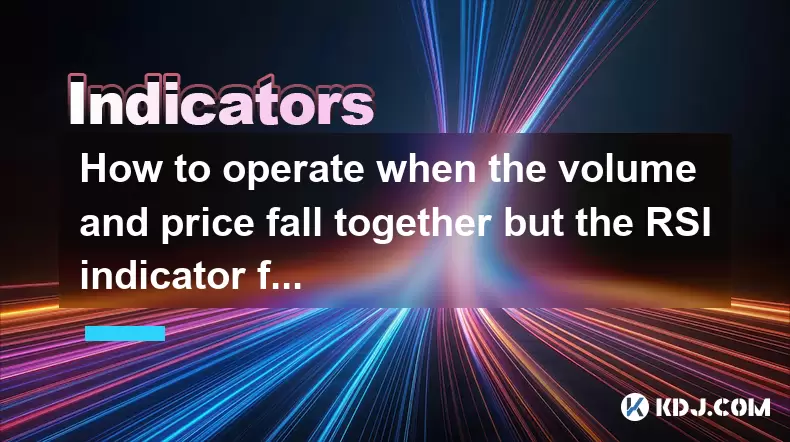
How to operate when the volume and price fall together but the RSI indicator forms a bottom divergence?
Jun 25,2025 at 04:29am
Understanding the Concept of RSI Bottom DivergenceWhen analyzing cryptocurrency price charts, traders often rely on technical indicators to spot potential reversals. One such signal is a bottom divergence in the Relative Strength Index (RSI). This occurs when the price makes a new low, but the RSI does not confirm that low and instead forms a higher low...
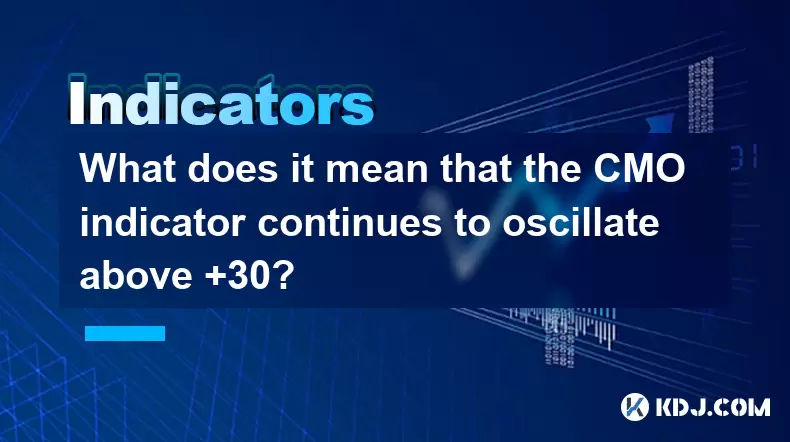
What does it mean that the CMO indicator continues to oscillate above +30?
Jun 25,2025 at 03:29am
Understanding the CMO IndicatorThe Chande Momentum Oscillator (CMO) is a technical analysis tool developed by Tushar Chande to measure momentum in financial markets. In cryptocurrency trading, the CMO helps traders identify overbought or oversold conditions and potential trend reversals. The oscillator ranges from -100 to +100, with values above zero in...

What does it mean that the ATR indicator suddenly doubles after hitting a new low this year?
Jun 24,2025 at 11:57pm
Understanding the ATR IndicatorThe Average True Range (ATR) is a technical analysis indicator used to measure market volatility. Developed by J. Welles Wilder, ATR calculates the average price range between a security’s high and low over a specific period—typically 14 periods. It does not indicate the direction of price movement but rather how volatile ...
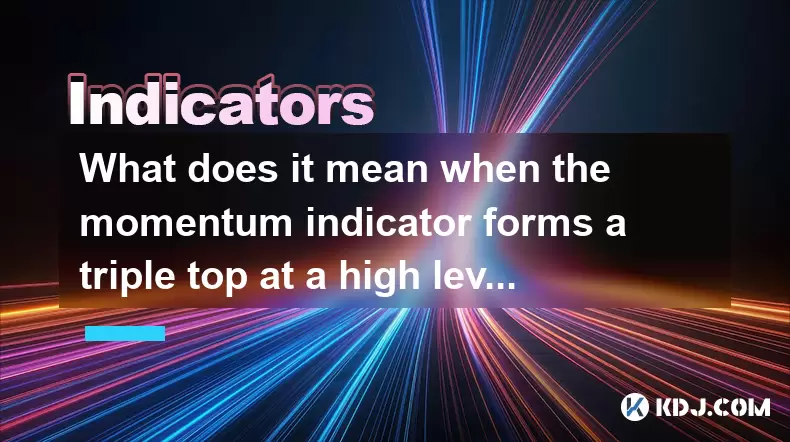
What does it mean when the momentum indicator forms a triple top at a high level?
Jun 25,2025 at 03:15am
Understanding the Momentum Indicator in Cryptocurrency TradingThe momentum indicator is a widely used technical analysis tool that measures the rate of change in price movements over a specified period. In cryptocurrency trading, where volatility is high and trends can reverse rapidly, this indicator helps traders identify potential trend reversals or c...

What does the divergence between the volatility indicator and the price indicate?
Jun 25,2025 at 06:07am
Understanding the Volatility IndicatorThe volatility indicator is a technical analysis tool used to measure the rate and magnitude of price movements in financial markets, including cryptocurrencies. It helps traders assess whether a market is experiencing high or low volatility, which can influence trading decisions. Common types of volatility indicato...
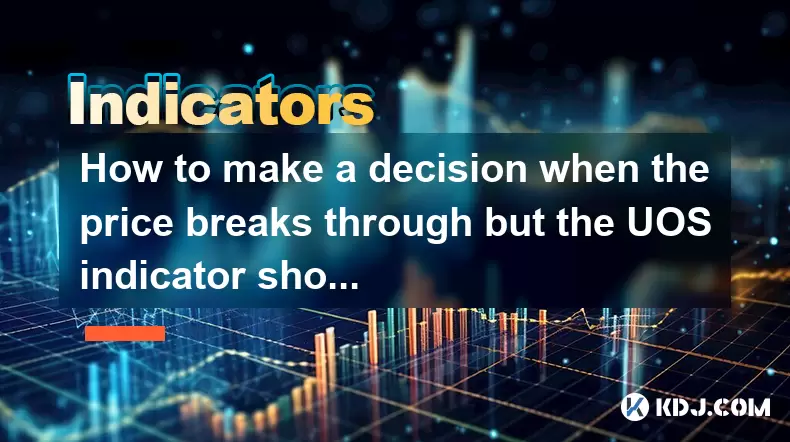
How to make a decision when the price breaks through but the UOS indicator shows a top divergence?
Jun 24,2025 at 11:42pm
Understanding the UOS Indicator and Price BreakthroughsThe Ultimate Oscillator (UOS) is a momentum oscillator that combines multiple timeframes to provide a more accurate picture of market momentum. When traders observe a price breakthrough — where the price moves above a key resistance level — but the UOS indicator shows a top divergence, it creates a ...

How to operate when the volume and price fall together but the RSI indicator forms a bottom divergence?
Jun 25,2025 at 04:29am
Understanding the Concept of RSI Bottom DivergenceWhen analyzing cryptocurrency price charts, traders often rely on technical indicators to spot potential reversals. One such signal is a bottom divergence in the Relative Strength Index (RSI). This occurs when the price makes a new low, but the RSI does not confirm that low and instead forms a higher low...

What does it mean that the CMO indicator continues to oscillate above +30?
Jun 25,2025 at 03:29am
Understanding the CMO IndicatorThe Chande Momentum Oscillator (CMO) is a technical analysis tool developed by Tushar Chande to measure momentum in financial markets. In cryptocurrency trading, the CMO helps traders identify overbought or oversold conditions and potential trend reversals. The oscillator ranges from -100 to +100, with values above zero in...

What does it mean that the ATR indicator suddenly doubles after hitting a new low this year?
Jun 24,2025 at 11:57pm
Understanding the ATR IndicatorThe Average True Range (ATR) is a technical analysis indicator used to measure market volatility. Developed by J. Welles Wilder, ATR calculates the average price range between a security’s high and low over a specific period—typically 14 periods. It does not indicate the direction of price movement but rather how volatile ...

What does it mean when the momentum indicator forms a triple top at a high level?
Jun 25,2025 at 03:15am
Understanding the Momentum Indicator in Cryptocurrency TradingThe momentum indicator is a widely used technical analysis tool that measures the rate of change in price movements over a specified period. In cryptocurrency trading, where volatility is high and trends can reverse rapidly, this indicator helps traders identify potential trend reversals or c...

What does the divergence between the volatility indicator and the price indicate?
Jun 25,2025 at 06:07am
Understanding the Volatility IndicatorThe volatility indicator is a technical analysis tool used to measure the rate and magnitude of price movements in financial markets, including cryptocurrencies. It helps traders assess whether a market is experiencing high or low volatility, which can influence trading decisions. Common types of volatility indicato...

How to make a decision when the price breaks through but the UOS indicator shows a top divergence?
Jun 24,2025 at 11:42pm
Understanding the UOS Indicator and Price BreakthroughsThe Ultimate Oscillator (UOS) is a momentum oscillator that combines multiple timeframes to provide a more accurate picture of market momentum. When traders observe a price breakthrough — where the price moves above a key resistance level — but the UOS indicator shows a top divergence, it creates a ...
See all articles
























































































